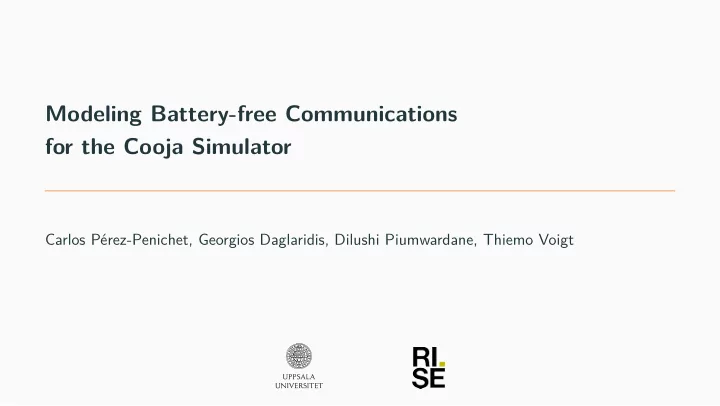

Modeling Battery-free Communications for the Cooja Simulator Carlos Pérez-Penichet, Georgios Daglaridis, Dilushi Piumwardane, Thiemo Voigt
Battery-free 802.15.4 Receiver Carlos Pérez-Penichet, Claro Noda, Ambuj Varshney, and Thiemo Voigt. In ACM/IEEE IPSN 2018 2
3
A Simulator is Useful 4
A Simulator is Useful 4
A Simulator is Useful 4
A Simulator is Useful 4
New Models for Carrier-Assisted Communications 1. Simple but realistic models inspired by experiments 2. Implement our models in the Cooja simulator 3. Illustrate how such a tool can be useful 5
Employ External Carrier to Transmit and Receive 7
Employ External Carrier to Transmit and Receive 7
Employ External Carrier to Transmit and Receive 7
Employ External Carrier to Transmit and Receive 7
Two Zones of Flawless Reception Transmission Reception 1.0 1.0 Experiment Experiment Flawless reception Flawless reception 0.8 0.8 0.6 0.6 PRR PRR 0.4 0.4 0.2 0.2 0.0 0.0 0 50 100 150 200 250 300 0 50 100 150 200 250 300 Tag's position [cm] Tag's Position [cm] 8
Cooja Implementation Contiki Carrier-Assisted Device Driver Cooja Radio Medium MSPSim Carrier-Assisted Transceiver Model 9
Cooja Implementation Contiki Carrier-Assisted Device Driver Cooja Radio Medium MSPSim Carrier-Assisted Transceiver Model 9
Carrier Assisted Device Model 10
Carrier Assisted Device Model 10
Cooja Implementation Contiki Carrier-Assisted Device Driver Cooja Radio Medium MSPSim Carrier-Assisted Transceiver Model 11
Cooja Implementation Contiki Carrier-Assisted Device Driver Cooja Radio Medium MSPSim Carrier-Assisted Transceiver Model 11
Cooja Implementation Contiki Carrier-Assisted Device Driver Cooja Radio Medium MSPSim Carrier-Assisted Transceiver Model 11
Radar Range Equation 65 Experiment 70 RSSI [dBm] 75 80 85 90 0 25 50 75 100 125 150 175 200 Tag's Position [cm] 13
Radar Range Equation 65 Theoretical Experiment 70 RSSI [dBm] 75 80 85 90 0 25 50 75 100 125 150 175 200 Tag's Position [cm] � � � � � � λ 2 P t G t b α | ∆Γ | 2 λ 2 G r G 2 P r = 16 π 2 R 2 16 π 2 R 2 4 1 2 13
Radar Range Equation 65 Theoretical Experiment 70 RSSI [dBm] 75 80 85 90 0 25 50 75 100 125 150 175 200 Tag's Position [cm] � � � � � � λ 2 P t G t b α | ∆Γ | 2 λ 2 G r G 2 P r = 16 π 2 R 2 16 π 2 R 2 4 1 2 13
Radar Range Equation 65 Theoretical Cooja 70 Experiment RSSI [dBm] 75 80 85 90 0 25 50 75 100 125 150 175 200 Tag's Position [cm] � � � � � � λ 2 P t G t b α | ∆Γ | 2 λ 2 G r G 2 P r = 16 π 2 R 2 16 π 2 R 2 4 1 2 13
Two Zones of Flawless Reception Transmission 1.0 Experiment Flawless reception 0.8 0.6 PRR 0.4 0.2 0.0 0 50 100 150 200 250 300 Tag's position [cm] 14
Two Zones of Flawless Reception Transmission 1.0 Experiment Cooja 0.8 Flawless reception 0.6 PRR 0.4 0.2 0.0 0 50 100 150 200 250 300 Tag's position [cm] 14
Receiver Sensitivity Depends on Carrier Strength Sensitivity threshold [dBm] Experimental 35 40 45 50 30.0 27.5 25.0 22.5 20.0 17.5 15.0 Carrier power [dBm] 15
Receiver Sensitivity Depends on Carrier Strength Sensitivity threshold [dBm] Experimental 35 Linear regression 40 45 50 30.0 27.5 25.0 22.5 20.0 17.5 15.0 Carrier power [dBm] 15
Two Zones of Flawless Reception (Receiver edition) Reception 1.0 Experiment Flawless reception 0.8 0.6 PRR 0.4 0.2 0.0 0 50 100 150 200 250 300 Tag's Position [cm] 16
Two Zones of Flawless Reception (Receiver edition) Reception 1.0 Experiment Cooja 0.8 Flawless reception 0.6 PRR 0.4 0.2 0.0 0 50 100 150 200 250 300 Tag's Position [cm] 16
17
Multi-carrier Backscatter 1 5 Carrier Receivers Generators 2 6 4 C A 3 Transceiver 7 Carrier 1 2 Listen 3 Carrier 4 5 TX 6 7 RX Varshney et al. In ACM SenSys 2017 18
Reflection Interference Receiver 1 4 Transmitters 3 2 C A Transceiver TX 1 2 RX 3 4 Interfere 19
Multi-carrier Interference 1 3 4 Carrier Generators C A Transmitter Transceiver 2 Carrier 1 2 TX 3 4 Interfere 20
21
Sensor Tag Scenario 1 2 ... N 22
Evaluating Protocols’ Energy Consumption 1.4 Energy per useful packet [ J] Pure ALOHA 1.2 Slotted ALOHA 1.0 TDMA 0.8 0.6 0.4 0.2 0.0 1 2 3 4 Number of nodes ( N ) 23
Evaluating Protocols’ Energy Consumption Periodic listening 1.0 0.8 0.6 CDF = 50ms 0.4 = 100ms = 200ms 0.2 = 800ms 0.0 0 200 400 600 800 1000 1200 Energy per join [ J] 24
Evaluating Protocols’ Energy Consumption Periodic listening Constant listening 1.0 1.0 0.8 0.8 0.6 0.6 CDF CDF = 50ms = 50ms 0.4 0.4 = 100ms = 100ms = 200ms = 200ms 0.2 0.2 = 800ms = 800ms 0.0 0.0 0 200 400 600 800 1000 1200 0 50 100 150 200 250 300 Energy per join [ J] Energy per join [ J] 24
Evaluating Protocols’ Energy Consumption Periodic listening Constant listening Active join request 1.0 1.0 1.0 0.8 0.8 0.8 0.6 0.6 0.6 CDF CDF CDF = 50ms = 50ms 0.4 0.4 0.4 = 100ms = 100ms = 200ms = 200ms 0.2 0.2 0.2 = 800ms = 800ms 0.0 0.0 0.0 0 200 400 600 800 1000 1200 0 50 100 150 200 250 300 0 10 20 30 40 50 60 Energy per join [ J] Energy per join [ J] Energy per join [ J] 24
New Models for Carrier-Assisted Communications 1. Simple but realistic models inspired by experiments 2. Implement our models in the Cooja simulator 3. Illustrate how such a tool can be useful 25
Available Today 3 Unmodulated 802.15.4 frames carrier 1 2 Carrier-Assisted Transceiver https://github.com/cperezpenichet/contiki-ng/tree/carrier-assisted carlos.penichet@it.uu.se 26
Recommend
More recommend